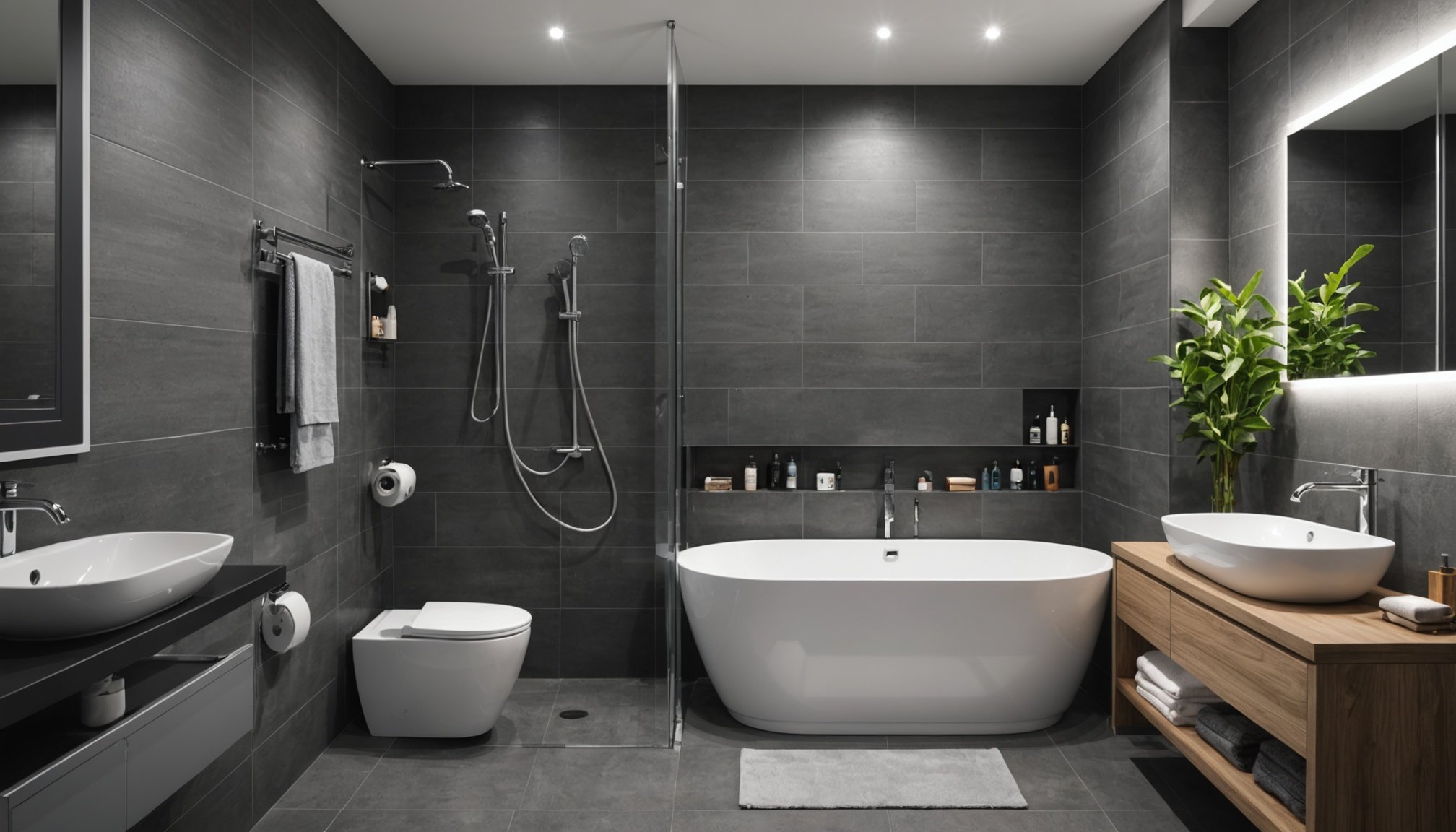Creating a wheelchair-friendly bathroom is essential for fostering independence and comfort. Thoughtful design can transform it into a functional and soothing space. Prioritising accessibility means considering layout, fixtures, and materials that promote ease of use. This guide offers practical tips on optimising space, ensuring safety, and enhancing usability, making your bathroom not just accessible, but truly welcoming for everyone. Embrace these insights to make a significant difference in daily routines.
Understanding Accessibility in Bathroom Design
Exploring the essentials of creating inclusive spaces
Additional reading : Discover the Most Affordable Techniques for Installing Underfloor Heating in Concrete Floors
Overview of Accessibility Standards
Creating a bathroom design that meets accessibility standards is crucial for ensuring that all individuals, regardless of ability, can use the space safely and comfortably. These standards are often guided by the ADA compliance regulations, which set forth specific criteria to accommodate people with disabilities. The ADA, or Americans with Disabilities Act, mandates features such as grab bars, accessible sinks, and appropriate door widths.
Importance of ADA Compliance
ADA compliance is more than a legal requirement; it is a commitment to inclusivity and equality. Compliant bathroom designs not only meet the needs of individuals with disabilities but also enhance the overall usability of the space. This can include features like non-slip flooring and easy-to-reach fixtures, benefiting everyone.
Have you seen this : Discover the Most Affordable Techniques for Installing Underfloor Heating in Concrete Floors
Key Principles of Inclusive Design
Inclusive design principles focus on creating environments that are usable by all people, to the greatest extent possible, without the need for adaptation. Key principles include:
- Flexibility in use
- Simple and intuitive design
- Perceptible information
Implementing these principles ensures a bathroom design that is not only functional but also welcoming and accommodating to all users. By adhering to accessibility standards and embracing inclusive design, designers can create spaces that truly cater to the diverse needs of their users.
Essential Layout Tips for a Wheelchair-Friendly Bathroom
Designing a wheelchair-friendly bathroom requires careful planning to ensure accessibility and ease of use. Here are some key considerations:
Optimal Dimensions for Maneuverability
Creating sufficient space is crucial for wheelchair accessibility. A clear floor area of at least 60 inches in diameter is recommended to allow a wheelchair turning radius. This ensures that users can navigate the space without difficulty.
Ideal Placement of Fixtures
Positioning fixtures strategically is essential in a bathroom layout. Ensure that sinks, toilets, and showers are within easy reach. For example, place sinks at a height of 34 inches or less. This provides convenience and maintains accessibility.
Considerations for Doorways and Pathways
Doorways should be at least 32 inches wide to accommodate wheelchair accessibility. Additionally, pathways must be unobstructed to facilitate smooth movement.
- Space requirements for turning
- Recommended distances between fixtures
- Easy access to essential features
By focusing on these aspects, you can create a bathroom layout that is both functional and inclusive. Consider these space requirements to enhance the usability of the bathroom for all users.
Choosing the Right Fixtures for Accessibility
Making informed choices about accessible fixtures is essential for creating a bathroom that is both functional and welcoming.
Recommended Types of Toilets and Sinks
Selecting the right ADA-compliant toilets and sinks is crucial for accessibility. Toilets should be between 17-19 inches from the floor to the seat, ensuring ease of transfer from a wheelchair. Wall-mounted sinks offer flexibility, allowing users to roll under them with ease.
Importance of Grab Bars and Their Placement
Grab bars play a vital role in safety and support. They should be installed near toilets and in showers to assist with movement and balance. The recommended height for grab bars is 33-36 inches from the floor. Proper placement ensures that they provide maximum benefit.
Selection of Faucets and Shower Controls
Choosing user-friendly faucets and shower controls enhances accessibility. Lever handles are ideal, as they require minimal force to operate. Additionally, thermostatic controls with clear markings help maintain safe water temperatures.
- Accessible fixtures should be easy to use
- ADA-compliant toilets enhance usability
- Grab bars must be securely installed
By focusing on these elements, you can ensure that the bathroom is both practical and inclusive, meeting the diverse needs of all users.
Materials and Finishes That Enhance Accessibility
Choosing the right materials and finishes is essential for creating a safe and accessible bathroom environment.
Best Flooring Options for Safety and Accessibility
Slip-resistant surfaces are crucial in bathroom design to prevent accidents, especially in wet areas. Consider materials like textured tiles or rubber flooring, which provide excellent traction. These options not only enhance safety but also meet accessibility standards by reducing the risk of slips and falls.
Wall Materials That Are Both Functional and Aesthetic
When selecting wall materials, opt for durable materials that withstand moisture and daily wear. Ceramic or porcelain tiles are ideal as they are both resilient and easy to clean. Additionally, these materials contribute to the bathroom's aesthetic appeal, combining functionality with design.
Countertop Materials for Durability and Maintenance
For countertops, choose easy-to-clean finishes such as quartz or solid surface materials. These options are not only durable but also resistant to stains and moisture. Ensuring that countertops are both robust and low-maintenance is vital for long-term usability.
- Slip-resistant surfaces enhance safety
- Durable materials ensure longevity
- Easy-to-clean finishes simplify maintenance
By integrating these elements, you create a bathroom that is both functional and visually appealing, catering to the needs of all users.
Cost Considerations and Resources for Designing Accessible Bathrooms
Exploring budget-friendly options and helpful resources.
Overview of Potential Costs
Designing an accessible bathroom can involve a range of expenses, depending on the extent of renovations needed. Budgeting for accessibility is crucial, as costs can vary from minor adjustments to complete overhauls. Key factors influencing cost include labor, materials, and the complexity of the design.
Cost-Effective Solutions
Implementing cost-effective solutions can significantly enhance accessibility without overspending. Consider prioritizing essential modifications like installing grab bars, widening doorways, and choosing slip-resistant surfaces. These changes can improve safety and functionality while remaining budget-friendly. Additionally, opting for ADA-compliant fixtures can prevent costly future modifications.
Useful Resources
Numerous resources can assist in planning and executing accessible bathroom designs. Consulting with professionals specializing in accessibility can provide valuable insights. Additionally, exploring online platforms and design guides can offer inspiration and practical solutions.
- Local government programs may offer financial assistance
- Nonprofit organizations often provide guidance and support
- Home improvement retailers can advise on affordable materials
By leveraging these resources, you can achieve a balance between cost-effective solutions and high-quality design, ensuring a bathroom that meets both budgetary and accessibility needs.











